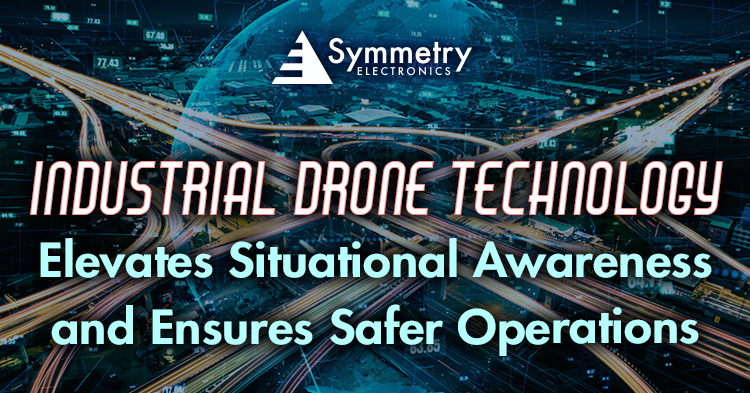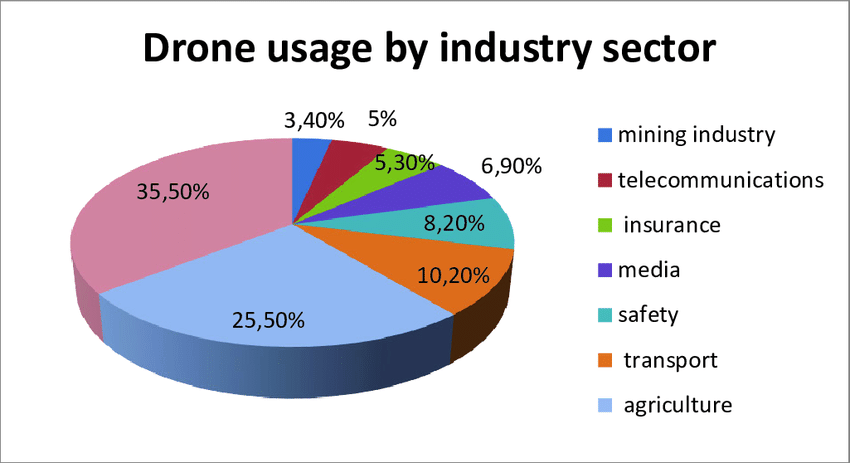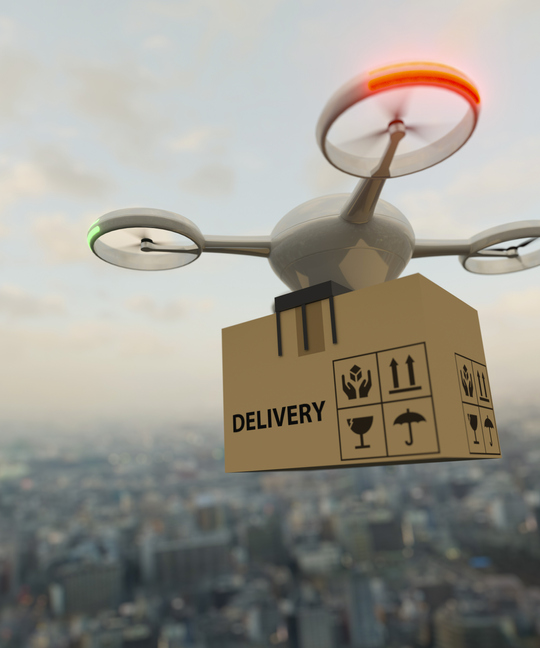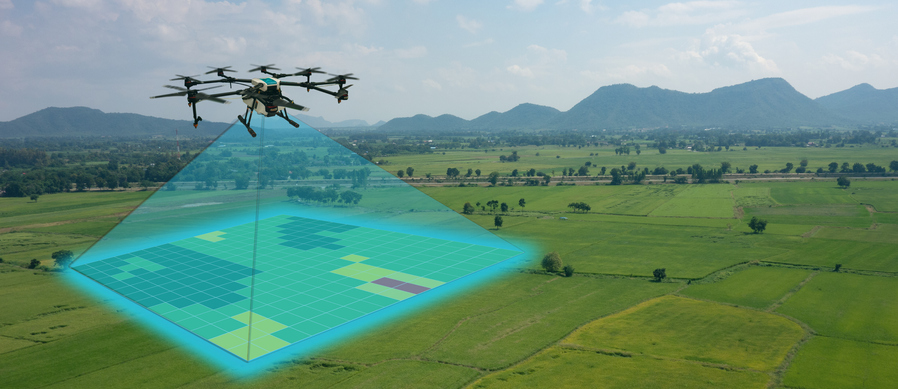- Home
- Symmetry Blog
- How Industrial Drone Technology Elevates Situational Awareness and Ensures Safer Operations
How Industrial Drone Technology Elevates Situational Awareness and Ensures Safer Operations
About Jari Haiston

Increasing situational awareness with industrial drones is revolutionizing workplace safety across various industries. By leveraging their aerial capabilities, real-time data collection, and remote monitoring features, industrial drones provide a powerful tool for enhancing situational awareness in work environments. Improved situational awareness enables operators to identify potential risks, assess hazardous conditions, and make informed decisions to prevent accidents and respond swiftly to emergencies. With the ability to access inaccessible areas, monitor large spaces, and gather valuable data, industrial drones play a crucial role in creating safer workplaces by equipping personnel with the knowledge and insights needed to implement proactive safety measures and ensure the well-being of employees and assets.
What is an Industrial Drone?
An industrial drone, also known as a commercial or professional drone, is an unmanned aerial vehicle (UAV) specifically designed and built for industrial or commercial purposes. Unlike recreational or consumer-grade drones, industrial drones are robust, equipped with advanced technology, and tailored to meet the specific needs of various industries.
Industrial drones are utilized in a wide range of sectors, including construction, agriculture, energy, infrastructure inspection, surveying, mining, and public safety. These drones are equipped with sensors, cameras, and other state-of-the-art components to perform specific tasks such as aerial mapping, inspection, monitoring, data collection, transportation, and more (Figure 1).
Industrial drones are typically designed for extended flight times, have a higher payload capacity, and are capable of withstanding harsh environmental conditions. They often feature advanced flight control systems, GPS navigation, obstacle detection and avoidance, and autonomous flight capabilities. These features enable precise and efficient operations while ensuring operational safety.
Industrial Drones vs Traditional Drones
In comparison to each other, industrial drones and traditional drones differ in several key aspects. Industrial drones are specifically designed and equipped for professional or commercial applications in various industries such as infrastructure inspection, agriculture, or surveying. They often possess advanced capabilities, such as longer flight times, higher payload capacities, and specialized sensors or cameras for data collection and analysis. Industrial drones prioritize robustness, reliability, and functionality to meet the demands of professional use. In contrast, traditional drones are typically consumer-grade recreational or hobbyist drones used for personal enjoyment or basic aerial photography. They may have more limited capabilities, shorter flight times, and less advanced features compared to industrial drones.Overall, industrial drones offer significant advantages, including cost and time savings, enhanced safety, improved data accuracy, and the ability to access and monitor hard-to-reach or hazardous areas. The trending statistics behind commercial drone integration are already beginning to prove the technology’s success rate. According to Grand View Research, the global commercial drone market was valued at $29.86 billion in 2022. It’s expected to increase at a significant CAGR of 38.6% from 2023 to 2030. As technology continues to advance, industrial drones are expected to play an increasingly crucial role in transforming various industries and optimizing operations.

Industrial Drone Use Cases
The applications of industrial drones are diverse. They can be used for aerial surveys and mapping to collect geospatial data, monitor and inspect infrastructure such as buildings, bridges, and pipelines, perform crop monitoring and precision agriculture in the farming industry, conduct search and rescue operations, and even transport goods in certain scenarios. Industrial drones have numerous use cases across various industries. Some common applications include:
- Aerial Inspections: Drones can be equipped with cameras, sensors, or thermal imaging devices to inspect infrastructure such as power lines, pipelines, bridges, and buildings. They can quickly and safely assess the condition, detect damages or anomalies, and provide detailed visual data for analysis.
- Agriculture: Drones can assist in precision farming by collecting data on crop health, moisture levels, and nutrient distribution. This information helps farmers optimize irrigation, fertilizer application, and identify areas of pest infestation or disease outbreak. Drones can also be used for aerial seeding or spraying pesticides.
- Construction and Surveying: Drones can generate highly accurate 3D maps and models of construction sites, providing valuable data for surveying, land management, and project monitoring. They can be used to track progress, assess site conditions, and plan the placement of equipment or structures.
- Search and Rescue Operations: Drones equipped with thermal cameras and GPS systems are employed in search and rescue missions to locate missing persons or stranded individuals in remote or hazardous environments. They can cover large areas quickly and provide real-time information to aid rescue teams.
- Industrial Security: Drones can enhance security measures by monitoring critical infrastructure, industrial sites, or large events. They can patrol perimeters, identify security breaches, and transmit live video feeds to a central command center, enabling real-time response and threat assessment.
- Logistics and Warehousing: Drones are being explored for last-mile delivery in logistics operations, particularly for small and urgent packages. They can transport goods quickly, bypassing traffic congestion, and reaching remote or difficult-to-access locations. In warehouses, drones can automate inventory management and stocktaking processes.
- Environmental Monitoring: Drones equipped with sensors and cameras are employed in environmental monitoring efforts. They can assess air quality, measure pollution levels, monitor wildlife populations, and gather data on ecosystem health. This information aids researchers, conservationists, and policymakers in making informed decisions.
- Mining and Resource Exploration: Drones assist in the mapping and exploration of mining sites by capturing aerial imagery, conducting geophysical surveys, or analyzing rock formations. They help identify potential mineral deposits, plan excavation activities, and assess the environmental impact of mining operations.
As technology advances, new use cases continue to emerge, expanding the capabilities and potential of drones in various industries. Industry powerhouses are already beginning to adopt initiatives in an effort to harness and adopt emerging drone technology. In 2022, FedEx announced that it would be utilizing Elroy Air to test autonomous drone cargo delivery. That same year, Walmart also announced that it would begin providing 4 million U.S. households with the convenience of drone delivery through a partnership with DroneUp.

Three Levels of Situational Awareness
Situational awareness refers to the perception and understanding of the current environment, including the people, objects, events, and conditions within it, and the ability to comprehend their meaning and potential implications. It involves being cognizant of the relevant information, assessing its significance, and making informed decisions based on that understanding.
Situational awareness can be applied to various contexts, including personal, professional, and operational settings. It plays a crucial role in fields such as aviation, military operations, emergency response, healthcare, and many others where effective decision-making and response are critical.
Actually, there are three levels of situational awareness:
- Perception: This level involves perceiving the elements and factors present in the environment through observation, sensory input, and data collection.
- Comprehension: Once the relevant information is perceived, the next step is to comprehend and understand its meaning and implications. This involves processing and analyzing the data, recognizing patterns, and establishing connections between different elements or events. It requires synthesizing information from multiple sources and forming a coherent mental model of the situation.
- Projection: The highest level of situational awareness involves projecting or anticipating future developments and outcomes based on the current understanding of the situation. It requires considering potential scenarios, assessing risks and opportunities, and making predictions about how the situation may evolve over time. This level enables proactive decision-making and planning to effectively respond to the situation.
Situational awareness is crucial in dynamic and complex environments, where the ability to quickly assess and adapt to changing circumstances is vital. It enables individuals or teams to make timely and informed decisions, respond effectively to challenges or threats, and maintain a high level of performance and safety.

How Do Industrial Drones Enhance Situational Awareness?
Industrial drones can significantly contribute to meeting all three levels of situational awareness by providing valuable aerial perspectives, real-time data, and remote sensing capabilities. By contributing to the perception, comprehension, and projection of the current situation, industrial drones enhance situational awareness, enabling operators to make more informed and proactive decisions. This, in turn, promotes improved safety measures, response capabilities, and overall efficiency in a variety of industries and work environments.
Industrial drones enhance situational awareness through the following tasks:
- Aerial View and Monitoring: Drones offer a bird's-eye view of the environment, providing a comprehensive and detailed perspective that is otherwise challenging or time-consuming to obtain. By capturing high-resolution imagery or video footage, drones enable operators to monitor large areas, infrastructure, or operational sites with ease. This aerial view enhances situational awareness by revealing spatial relationships, identifying potential hazards or obstacles, and offering a broader understanding of the surroundings.
- Real-time Data Collection: Drones equipped with sensors, cameras, or other specialized equipment can collect real-time data and transmit it to operators or decision-makers on the ground. This data includes visual information, thermal imaging, atmospheric conditions, pollutant levels, or other relevant parameters. Real-time data feeds allow for immediate analysis and interpretation, enabling operators to stay informed about the current status of the situation and make timely decisions based on the latest information.
- Remote Monitoring and Surveillance: Drones equipped with cameras or sensors can be deployed to remotely monitor critical infrastructure, industrial facilities, or sensitive areas. They provide continuous surveillance, detecting anomalies, unauthorized activities, or safety breaches. By transmitting live video feeds or sensor data, drones enable operators to monitor the situation in real time, identify potential risks or security threats, and respond promptly to emerging situations.
- Rapid and Safe Assessments: Drones can quickly and safely assess challenging or inaccessible areas, such as tall structures, rooftops, or remote terrains. They eliminate the need for manual inspections or the deployment of personnel in hazardous environments. By conducting efficient inspections and assessments, drones accelerate the data collection process and reduce the time required to gather relevant information. This timely assessment enhances situational awareness and enables faster decision-making.
- Multi-sensor Capabilities: Drones can be equipped with various sensors, including thermal cameras, LiDAR (Light Detection and Ranging), gas detectors, or environmental sensors. This multi-sensor capability allows them to gather diverse types of data simultaneously, providing a more comprehensive understanding of the situation. For example, thermal cameras can detect heat signatures in search and rescue operations, or environmental sensors can monitor pollution levels in industrial areas.
- Mapping and 3D Modeling: Drones equipped with photogrammetry or LiDAR sensors can generate high-resolution 3D maps and models of the environment. These detailed representations aid in spatial analysis, volume calculations, and identification of features or changes. By having accurate and up-to-date maps or models, operators can better comprehend the terrain, infrastructure, or assets involved, improving overall situational awareness.
By leveraging these capabilities, industrial drones enhance situational awareness by providing valuable aerial perspectives, real-time data collection, and remote monitoring capabilities. This enables operators to make more informed decisions, respond effectively to evolving situations, and improve overall operational efficiency and safety.
Creating Safer Workplaces with Industrial Drone Technology
Increasing situational awareness with industrial drones brings significant benefits to creating safer workplaces. By providing aerial perspectives, real-time data collection, and remote monitoring capabilities, industrial drones enable operators to have a comprehensive understanding of their environment, identifying potential risks, hazards, or security breaches. With enhanced situational awareness, proactive measures can be taken to prevent accidents, respond swiftly to emergencies, and implement appropriate safety protocols. Drones facilitate efficient inspections of hazardous areas, reducing the need for human presence in dangerous environments. Timely and informed decision-making based on drone-generated data ensures that safety measures are implemented promptly and effectively, ultimately fostering safer workplaces and protecting the well-being of workers and assets.
If you’re a developer looking to create an industrial drone to meet your needs, our team of Applications Engineers are experts in industrial internet of things (IIoT), industry 4.0, and next-generation solutions and can assist you in discovering your ideal device design. Consultation is free and available throughout your design cycle. Contact Symmetry Electronics today!
